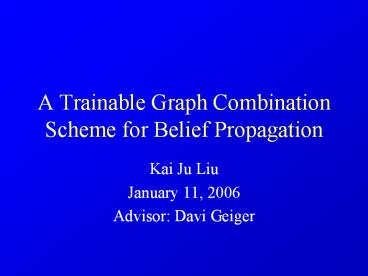A Trainable Graph Combination Scheme for Belief Propagation
1 / 40
Title:
A Trainable Graph Combination Scheme for Belief Propagation
Description:
A Trainable Graph Combination Scheme for Belief Propagation – PowerPoint PPT presentation
Number of Views:70
Avg rating:3.0/5.0
Title: A Trainable Graph Combination Scheme for Belief Propagation
1
A Trainable Graph Combination Scheme for Belief
Propagation
- Kai Ju Liu
- January 11, 2006
- Advisor Davi Geiger
2
Images
3
Pairwise Markov Random Field
- Basic structure graph of vertices connected by
edges - Each vertex has
- observed value y
- set of possible states X
- Goal to state something about vertex states
given observed data
4
Pairwise MRF Compatibility Functions
- Statistical dependency between yi and xi
- fi(xi, yi)
- Relation between neighboring vertices i and j
- yij(xi, xj)
5
Pairwise MRF Joint Probability
- Consider MRF with n vertices
- Proportional to product of compatibility
functions - Yields most likely set of states xi
6
Pairwise MRF Marginal Probability
- Yields vertex is most likely state xi
- Allows average over unknown states
- Complexity exponential in number of vertices
7
Pairwise MRF Probability Inefficiencies
- Joint probabilities share common terms
- Probability calculations can be much more
efficient
8
Belief Propagation
- Accumulate probability calculations at vertices
- Beliefs replace probabilities
9
BP Messages
- mji(xi), message vertex j passes to vertex i
- How likely vertex j thinks, given knowledge from
ancestors, that vertex i is in state xi
10
BP Applications
- Medical diagnoses
- Symptoms to diseases
- Insurance policies
- Various factors to risk assessment
11
BP Concerns
- When can we calculate beliefs exactly?
- When do beliefs equal probabilities?
- When is belief propagation efficient?
12
BP Singly-Connected Graphs (SCGs)
- Graphs without loops
- Messages terminate at leaf vertices
- Beliefs equal probabilities
13
BP SCG Complexity
- S states per vertex
- Marginal probabilities 8S5 multiplications, 5S5
additions - Beliefs 16S2 multiplications, 8S2 additions
14
BP Loopy Graphs
- Majority of useful graphs are loopy
- Message update rules are circular
15
BP Energy
- Boltzmanns equation converts probability to
energy - Search for energy approximations
16
Standard Belief Propagation
- Based on Bethe approximation to free energy
- Follows belief propagation rules
- Initialize messages to 1.0
- Update self-consistently until convergence
17
Generalized Belief Propagation
- Based on Kikuchi approximation to free energy
- Passes messages between regions
18
BP-TwoGraphs Goals
- Utilize properties of SCGs
- Accurate and efficient on loopy graphs
19
BP-TwoGraphs SCGs
- Consider loopy graph with n vertices
- Select two sets of SCGs that approximate the
graph
20
BP-TwoGraphs Combining SCGs
- Calculate beliefs on each set of SCGs
- biG(xi) and biH(xi)
- Select maximum beliefs from both sets
21
BP-TwoGraphs Image Segmentation SCGs
- Rectangular grid of pixel vertices
- Horizontal graphs
- Vertical graphs
- Belief propagation exact on these graphs
22
Test Case Image Segmentation
- Classic, difficult problem
- Test images generated from artificial image
23
Test Case BP-TwoGraphs Compatibility Functions
- f compatibility function must distinguish dark
from light - No grayscale level discounted
24
Test Case BP-TwoGraphs Compatibility Functions
- y function controls tendency for neighboring
vertices to be in same state - Distinguishes only between similar and dissimilar
states
25
Test Case Max-Flow
- Calculate maximum flows or minimum cuts of flow
networks - Flow network similar to pairwise MRF of
BP-TwoGraphs - Additional source and sink/target vertices
26
Test Case Max-Flow Capacities
- Linear source-to-vertex and vertex-to-sink
capacities similar to f compatibility function - No vertex disconnected from source or sink
- Capacity between pixel vertices m
27
Test Case Setup
Parameter Min. Max. Delta
Test Images Std. dev. 1.0 170.0 1.0
BP-TwoGraphs STICKINESS 0.5 1.0 0.0001
Max-Flow m 0.0 255.0 0.5
28
Test Case Results
29
Combined Graph Analysis
30
Combined Graph Analysis
31
Additional Comparisons I
32
Additional Comparisons II
33
Boundary-Based Image Segmentation
- Scale
- Image measurements
- Wavelets
- Windows of pixels
34
Boundary-Based Image Segmentation Window Vertices
- Square 2-by-2 window of pixels
- Each pixel has two states
- foreground
- background
35
Boundary-Based Image Segmentation Overlap
36
Boundary-Based Image Segmentation Graph
37
Boundary-Based Image Segmentation f
- Square l-by-l window vertices
- Each pixel has two states
- foreground
- background
38
Boundary-Based Image Segmentation y
- Scan rows/columns for directed pairs of
neighboring states - Rotate through 90, 180, 270 degrees
39
Boundary-Based Image Segmentation Training Images
40
Boundary-Based Image Segmentation Eagle Results
41
Boundary-Based Image Segmentation Gorilla Results
42
Conclusion
- BP-TwoGraphs
- Accurate and efficient
- Trainable parameters
- Extensive use of beliefs
- Future work
- Learning
- 3D data
- General graphs































